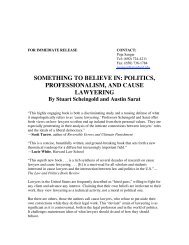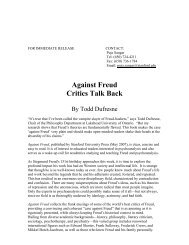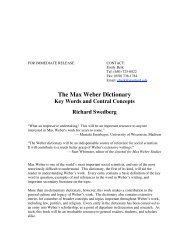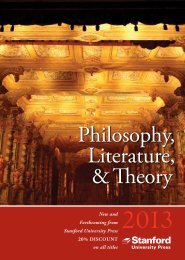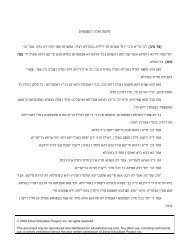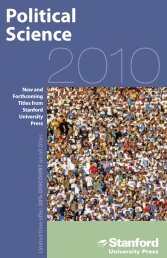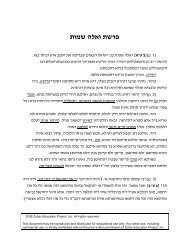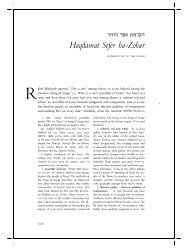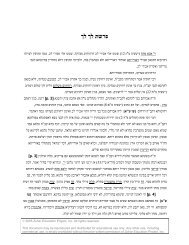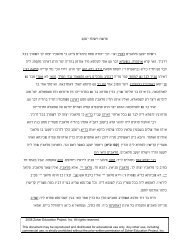Front Matter (PDF) - Stanford University Press
Front Matter (PDF) - Stanford University Press
Front Matter (PDF) - Stanford University Press
Create successful ePaper yourself
Turn your PDF publications into a flip-book with our unique Google optimized e-Paper software.
se®rotic universe as a representation of inner religious experience may<br />
The<br />
described in more speci®c ways as well, though these are surely not ex-<br />
be<br />
The ``descent'' of the se®rot, beginning with Keter, issaidtodescribe<br />
haustive.<br />
emergence of God from hiddenness to revelation. Both the creation of the<br />
the<br />
and the giving of Torah are this-worldly extensions of that inner divine<br />
world<br />
On a more realistic plane, however, so too is the mystic's own inner<br />
process.<br />
Se®rotic symbolism provides a language for describing the mystic's own<br />
life.<br />
from an experience of absorption in the ``nothingness'' of God and<br />
return<br />
reintegration into the framework of full human personality, the reemergence<br />
gradual<br />
of conscious selfhood. It should be emphasized that the Zohar never<br />
such a claim. In general the kabbalists were loathe to speak too openly<br />
makes<br />
the experiential aspects of their teaching. Especially when it came to the<br />
about<br />
triad of the se®rotic world, to speak in terms that claimed direct<br />
highest<br />
was considered far beyond the bounds of propriety. But one who<br />
experience<br />
the kabbalists with an eye to comparative and phenomenological descriptions<br />
reads<br />
of mysticism cannot but suspect that such experience underlies the<br />
The accounts of a mysterious energy that ¯ows from unde®ned endlessness,<br />
sources.<br />
through a primal arousal of will, into a single point that is the start of<br />
being, and thence into the womb-palace where the self (divine or human) is<br />
all<br />
sound familiarly like descriptions of the rebirth of personality that<br />
born,<br />
the contemplative mystical experience. Even though the Zohar depicts<br />
follows<br />
chie¯y as the original journey of God, we understand that the mystical life<br />
it<br />
that divine process. In fact, it is out of their own experience that the<br />
repeats<br />
know what they do of the original journey on which theirs is patterned.<br />
mystics<br />
one can go even a step further to claim that the constant movement<br />
Perhaps<br />
the se®rotic world, includingboth the ¯ow of energy ``downward'' from<br />
within<br />
and the risingup of Malkhut and the lower worlds into the divine heights,<br />
Keter<br />
the dynamic inner life of the mystic and the spiritual motion that<br />
represents<br />
animates his soul. It is these nuances of inner movement that constitute<br />
ever<br />
``real'' subject of a very large part of the Zohar and the world it creates. To<br />
the<br />
fully appreciate the Zohar as a mystical text is to understand these<br />
most<br />
as reverberations within the mystic's soul of events as they tran-<br />
movements<br />
within the se®rotic cosmos that constitutes the divine reality.<br />
spire<br />
the Zohar does speak of mystical experience, it is largely through use<br />
When<br />
the term devequt, ``attachment'' or ``cleaving '' to God, and its Aramaic<br />
of<br />
Ever since the early rabbinic discussions of Deuteronomy 4:4 (``You<br />
cognates.<br />
cleave to YHVH your God are all alive today'') and 10:20 (``Fear YHVH your<br />
who<br />
cleave to Him and serve Him''), devequt has played a central role in the<br />
God,<br />
life of pious Jews. But the Zohar is also quick to associate this term<br />
devotional<br />
its ®rst biblical usage in Genesis 2:24, where man ``cleaves to his wife and<br />
with<br />
become one ¯esh.'' Attachment to God, for the Zohar, is erotic attachment,<br />
they<br />
whether referringto the kabbalist's own attachment to God by means of<br />
Introduction<br />
lxvi<br />
Torah, to Shekhinah's link to the upper ``male'' se®rot as God's bride, or in the



